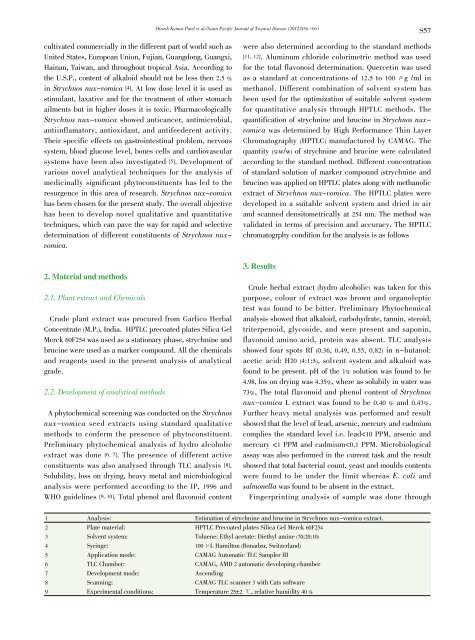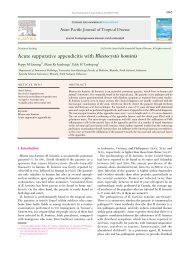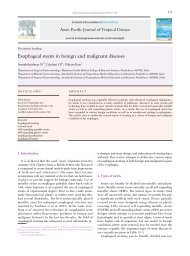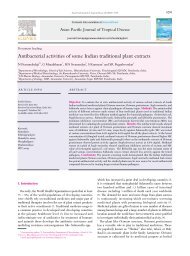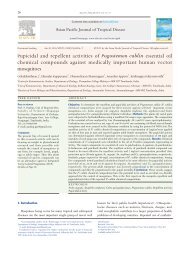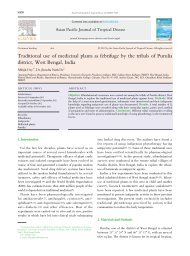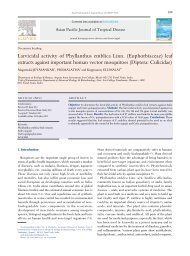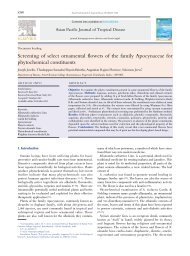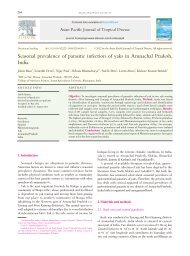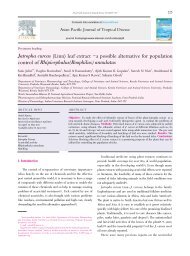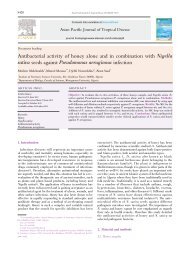Phytochemical analysis and standardization of Strychnos nux ...
Phytochemical analysis and standardization of Strychnos nux ...
Phytochemical analysis and standardization of Strychnos nux ...
You also want an ePaper? Increase the reach of your titles
YUMPU automatically turns print PDFs into web optimized ePapers that Google loves.
cultivated commercially in the different part <strong>of</strong> world such as<br />
United States, European Union, Fujian, Guangdong, Guangxi,<br />
Hainan, Taiwan, <strong>and</strong> throughout tropical Asia. According to<br />
the U.S.P., content <strong>of</strong> alkaloid should not be less then 2.5 %<br />
in <strong>Strychnos</strong> <strong>nux</strong>-vomica [4]. At low dose level it is used as<br />
stimulant, laxative <strong>and</strong> for the treatment <strong>of</strong> other stomach<br />
ailments but in higher doses it is toxic. Pharmacologically<br />
<strong>Strychnos</strong> <strong>nux</strong>-vomica showed anticancer, antimicrobial,<br />
antiinflamatory, antioxidant, <strong>and</strong> antifeederent activity.<br />
Their specific effects on gastrointestinal problem, nervous<br />
system, blood glucose level, bones cells <strong>and</strong> cardiovascular<br />
systems have been also investigated [5]. Development <strong>of</strong><br />
various novel analytical techniques for the <strong>analysis</strong> <strong>of</strong><br />
medicinally significant phytoconstituents has led to the<br />
resurgence in this area <strong>of</strong> research. <strong>Strychnos</strong> <strong>nux</strong>-vomica<br />
has been chosen for the present study. The overall objective<br />
has been to develop novel qualitative <strong>and</strong> quantitative<br />
techniques, which can pave the way for rapid <strong>and</strong> selective<br />
determination <strong>of</strong> different constituents <strong>of</strong> <strong>Strychnos</strong> <strong>nux</strong>vomica.<br />
2. Material <strong>and</strong> methods<br />
2.1. Plant extract <strong>and</strong> Chemicals<br />
Crude plant extract was procured from Garlico Herbal<br />
Concentrate (M.P.), India. HPTLC precoated plates Silica Gel<br />
Merck 60F254 was used as a stationary phase, strychnine <strong>and</strong><br />
brucine were used as a marker compound. All the chemicals<br />
<strong>and</strong> reagents used in the present <strong>analysis</strong> <strong>of</strong> analytical<br />
grade.<br />
2.2. Development <strong>of</strong> analytical methods<br />
A phytochemical screening was conducted on the <strong>Strychnos</strong><br />
<strong>nux</strong>-vomica seed extracts using st<strong>and</strong>ard qualitative<br />
methods to conferm the presence <strong>of</strong> phytoconstituent.<br />
Preliminary phytochemical <strong>analysis</strong> <strong>of</strong> hydro alcoholic<br />
extract was done [6, 7]. The presence <strong>of</strong> different active<br />
constituents was also analysed through TLC <strong>analysis</strong> [8].<br />
Solubility, loss on drying, heavy metal <strong>and</strong> microbiological<br />
<strong>analysis</strong> were performed according to the IP, 1996 <strong>and</strong><br />
WHO guidelines [9, 10]. Total phenol <strong>and</strong> flavonoid content<br />
Dinesh Kumar Patel et al./Asian Pacific Journal <strong>of</strong> Tropical Disease (2012)S56-S60 S57<br />
were also determined according to the st<strong>and</strong>ard methods<br />
[11, 12]. Aluminum chloride colorimetric method was used<br />
for the total flavonoid determination. Quercetin was used<br />
as a st<strong>and</strong>ard at concentrations <strong>of</strong> 12.5 to 100 毺g /ml in<br />
methanol. Different combination <strong>of</strong> solvent system has<br />
been used for the optimization <strong>of</strong> suitable solvent system<br />
for quantitative <strong>analysis</strong> through HPTLC methods. The<br />
quantification <strong>of</strong> strychnine <strong>and</strong> brucine in <strong>Strychnos</strong> <strong>nux</strong>vomica<br />
was determined by High Performance Thin Layer<br />
Chromatography (HPTLC) manufactured by CAMAG. The<br />
quantity (%w/w) <strong>of</strong> strychnine <strong>and</strong> brucine were calculated<br />
according to the st<strong>and</strong>ard method. Different concentration<br />
<strong>of</strong> st<strong>and</strong>ard solution <strong>of</strong> marker compound (strychnine <strong>and</strong><br />
brucine) was applied on HPTLC plates along with methanolic<br />
extract <strong>of</strong> <strong>Strychnos</strong> <strong>nux</strong>-vomica. The HPTLC plates were<br />
developed in a suitable solvent system <strong>and</strong> dried in air<br />
<strong>and</strong> scanned densitometrically at 254 nm. The method was<br />
validated in terms <strong>of</strong> precision <strong>and</strong> accuracy. The HPTLC<br />
chromatogrphy condition for the <strong>analysis</strong> is as follows<br />
3. Results<br />
Crude herbal extract (hydro alcoholic) was taken for this<br />
purpose, colour <strong>of</strong> extract was brown <strong>and</strong> organoleptic<br />
test was found to be bitter. Preliminary <strong>Phytochemical</strong><br />
<strong>analysis</strong> showed that alkaloid, carbohydrate, tannin, steroid,<br />
triterpenoid, glycoside, <strong>and</strong> were present <strong>and</strong> saponin,<br />
flavonoid amino acid, protein was absent. TLC <strong>analysis</strong><br />
showed four spots Rf (0.36, 0.49, 0.55, 0.82) in n-butanol:<br />
acetic acid: H20 (4:1:5), solvent system <strong>and</strong> alkaloid was<br />
found to be present. pH <strong>of</strong> the 1% solution was found to be<br />
4.98, los on drying was 4.35%, where as solubily in water was<br />
73%, The total flavonoid <strong>and</strong> phenol content <strong>of</strong> <strong>Strychnos</strong><br />
<strong>nux</strong>-vomica L extract was found to be 0.40 % <strong>and</strong> 0.43%.<br />
Further heavy metal <strong>analysis</strong> was performed <strong>and</strong> result<br />
showed that the level <strong>of</strong> lead, arsenic, mercury <strong>and</strong> cadmium<br />
complies the st<strong>and</strong>ard level i.e. lead


